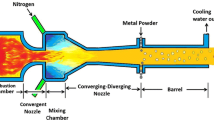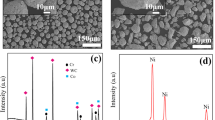Abstract
Pulsed detonation thermal spray coating is used to enhance the material properties at the surface of an object. The present research implements computational fluid dynamic modeling to identify the efficiency of energy and mass delivered to potential target locations. Six cases of a hydrogen-air mixture are used to investigate the gas flow from the instant of ignition to the instant of flow reversal at the tube exit. Flow monitors are included in the model to represent potential target locations. These monitors are placed at different axial locations in order to record mass flow rate and the flow rate of enthalpy over time. The results indicate that there exists a quasi-steady jet that is efficient and predictable in delivery of energy and mass from the tube exit to potential target locations positioned on the centerline. The duration of the quasi-steady jet is dependent on the fraction of combustible gas (i.e., % fill). Much of the initial energy and mass delivered from the jet avoids the flow monitors. This is found to be related to the evolution of the jet behind the blast wave where energy is lost in expansion and vorticity production. It is also found that nearly 11-18% of the available energy and 20-23% of the available mass remains in the tube after flow reversal.









Similar content being viewed by others
Abbreviations
- a :
-
speed of sound (m/s)
- A f :
-
pre-exponential factor (m3/kmol s) used in the Arrhenius expression
- D :
-
tube diameter (m)
- e :
-
specific internal energy (J/kg) (thermal or sensible only)
- E :
-
activation energy (J/kmol) used in the Arrhenius expression
- \( \ifmmode\expandafter\vec\else\expandafter\vec\fi{F}(\ifmmode\expandafter\vec\else\expandafter\vec\fi{U}) \) :
-
flux vector in the axial direction
- \( \ifmmode\expandafter\vec\else\expandafter\vec\fi{G}(\ifmmode\expandafter\vec\else\expandafter\vec\fi{U}) \) :
-
flux vector in the radial direction
- \( h^{{\text{o}}}_{{\text{f,i}}} \) :
-
enthalpy of formation of species i at standard state (1atm, 298.15k) (J/kmol)
- \( \ifmmode\expandafter\dot\else\expandafter\.\fi{H} \) :
-
flow rate of sensible enthalpy (kJ/s)
- \( \ifmmode\expandafter\vec\else\expandafter\vec\fi{J}(\ifmmode\expandafter\vec\else\expandafter\vec\fi{U}) \) :
-
source vector
- k f :
-
forward reaction rate
- k b :
-
backward reaction rate
- K(T)eq :
-
equilibrium constant
- L :
-
tube length (m)
- m :
-
mass (kg); with overdot signifies per unit time
- M w,i :
-
molecular weight of species i (kg/kmol)
- p :
-
pressure (Pa)
- r :
-
tube radius (m) or position or displacement in radial direction of cylindrical coordinate system (m)
- R U :
-
universal gas constant (J/kg·K)
- t :
-
time from an initial event or time from blast exiting the tube (s)
- T :
-
temperature (K)
- u :
-
velocity component in the axial direction (m/s)
- v x :
-
velocity in the axial direction, cylindrical coordinates (m/s)
- v r :
-
velocity in the radial direction, cylindrical coordinates (m/s)
- V :
-
velocity (m/s)
- Y i :
-
mass fraction of species i
- \( \ifmmode\expandafter\vec\else\expandafter\vec\fi{U} \) :
-
solution vector
- x :
-
position or displacement in axial direction of cylindrical coordinate system (m)
- β:
-
temperature exponent in the Arrhenius expression
- ρ:
-
density (kg/m3)
- \( \ifmmode\expandafter\dot\else\expandafter\.\fi{\upomega }_{i} \) :
-
rate of production (or destruction) of the species i (kmol/s m3)
- Δ:
-
difference between final and initial states
- 1:
-
state ahead of disturbance, downstream or low pressure region in shock tube
- 4:
-
high pressure region in shock tube
- e:
-
exit
- o :
-
standard state (1 atm)
- i :
-
species, or inlet
- atm:
-
atmosphere
- AUSM+:
-
Advection Upstream Splitting Method
- CJ:
-
Chapman-Jouguet
- CFD:
-
computational fluid dynamics
- CFL:
-
the Courant-Friedrichs-Lewy stability condition
- D1:
-
exterior flow monitor x = 1D from tube exit, centered on the centerline
- D2:
-
exterior flow monitor x = 2D from tube exit, centered on the centerline
- D3:
-
exterior flow monitor x = 3D from tube exit, centered on the centerline
- TVD:
-
total variation diminishing, referring to a numerical method in CFD
References
Fincke J.R., W.D. Swank, R.L. Bewley, D.C. Haggard, M. Gevelber, D. Wroblewski: “Diagnostics and Control in the Thermal Spray Process,” Surf. Coat. Technol., 2001, 146-147: 537-543
Assadi H., F. Gärtner, T. Stoltenhoff, and H. Kreye: Bonding Mechanism in Cold Gas Spraying, Acta Mater., 2003, 51:4379-4394
Stoltenhoff T., H. Kreye, H.J. Richter: “An Analysis of the Cold Spray Process and Its Coatings,” J. Therm. Spray Technol., 2001, 11:542-550
K.M., Ramadan, “A Computational Study of Pulsed Detonation Thermal Spraying,” PhD thesis, Department of Mechanical Engineering, The University of Iowa, 2002
Saravanan P, V. Selvarajan, D.S. Rao, S.V. Joshi, G. Sundararajan: “Influence of Process Variables on the Quality of Detonation Gun Sprayed Alumina Coatings,” Surf. Coat. Technol., 2000, 123:44-54
Ishii R., H. Fujimoto, N. Hatta, Y. Umeda: “Experimental and Numerical Analysis of Circular Pulse Jets,” J. Fluid Mech., 1999, 392, 129-153
K. Hsu and A. Jemcov, “Numerical Investigation of Detonation in Premixed Hydrogen-Air Mixture: Assessment of Simplified Chemical Mechanisms,” Technical Report AIAA-2000-2478 Presented at the Fluids 2000 Conference and Exhibit, June 19-22, 2000 (Denver, CO), 2000
Varma A.K., A.U. Chatwani, F.V. Bracco: “Studies of Premixed Laminar Hydrogen-Air Flames Using Elementary and Global Kinetics Models,” Combust. Flame, 1986, 64: 233-236
Anderson, J.D.: Modern Compressible Flow: With Historical Perspective, 3rd ed. 2003, New York: McGraw-Hill
P.B. Butler and R.G. Schmitt: “RGEQUIL,” 1995, The University of Iowa
A.P. Raghupathy, U. Ghia, and K. Ghia, “A Comparative Study of Chemical Mechanisms in the Simulation of One-Dimensional Detonation,” Paper Presented at the 42nd AIAA/ASME/SAE/ASEE Joint Propulsion Conference and Exhibit, July 9-12, 2006 (Sacramento, CA), 2006
Liou M.-S., C.J Steffen: “A New Flux Splitting Scheme,” J. Comput. Phys., 1993, 107: 23-39
Liou, M.-S.: “A Sequel to AUSM: AUSM+,” J. Comput. Phys., 1996, 129: 364-382
Dumbser M., J.-M. Moschetta, J. Gressier: A Matrix Stability Analysis of the Carbuncle Phenomenon,” J. Comput. Phys., 2004, 197: 647-670
Quirk, J.J.: “ A Contribution to the Great Riemann Solver Debate,” Intl. J. Numer. Meth. Fluid, 1994, 18: 555-574
S.R. Chakravarthy and S. Osher, “ A New Class of High Accuracy TVD Schemes for Hyperbolic Conservation Laws,” AIAA Paper, 1985, 85-0363
J.E. Cannon, “Thermal Efficiency Delivery of a Detonation Induced Pulse Jet,” M.S. thesis, Department of Mechanical Engineering, The University of Iowa, 2007
Kuo, K.K.: “ Principles of Combustion,” 2nd ed, 2005, New Jersey: John Wiley & Sons
Lin, S.-C.: “ Cylindrical Shock Waves Produced by Instantaneous Energy Release,” J. Appl. Phys., 1954, 25: 54-57
Author information
Authors and Affiliations
Corresponding author
Rights and permissions
About this article
Cite this article
Cannon, J.E., Alkam, M. & Butler, P.B. Efficiency of Pulsed Detonation Thermal Spraying. J Therm Spray Tech 17, 456–464 (2008). https://doi.org/10.1007/s11666-008-9202-4
Received:
Revised:
Accepted:
Published:
Issue Date:
DOI: https://doi.org/10.1007/s11666-008-9202-4




